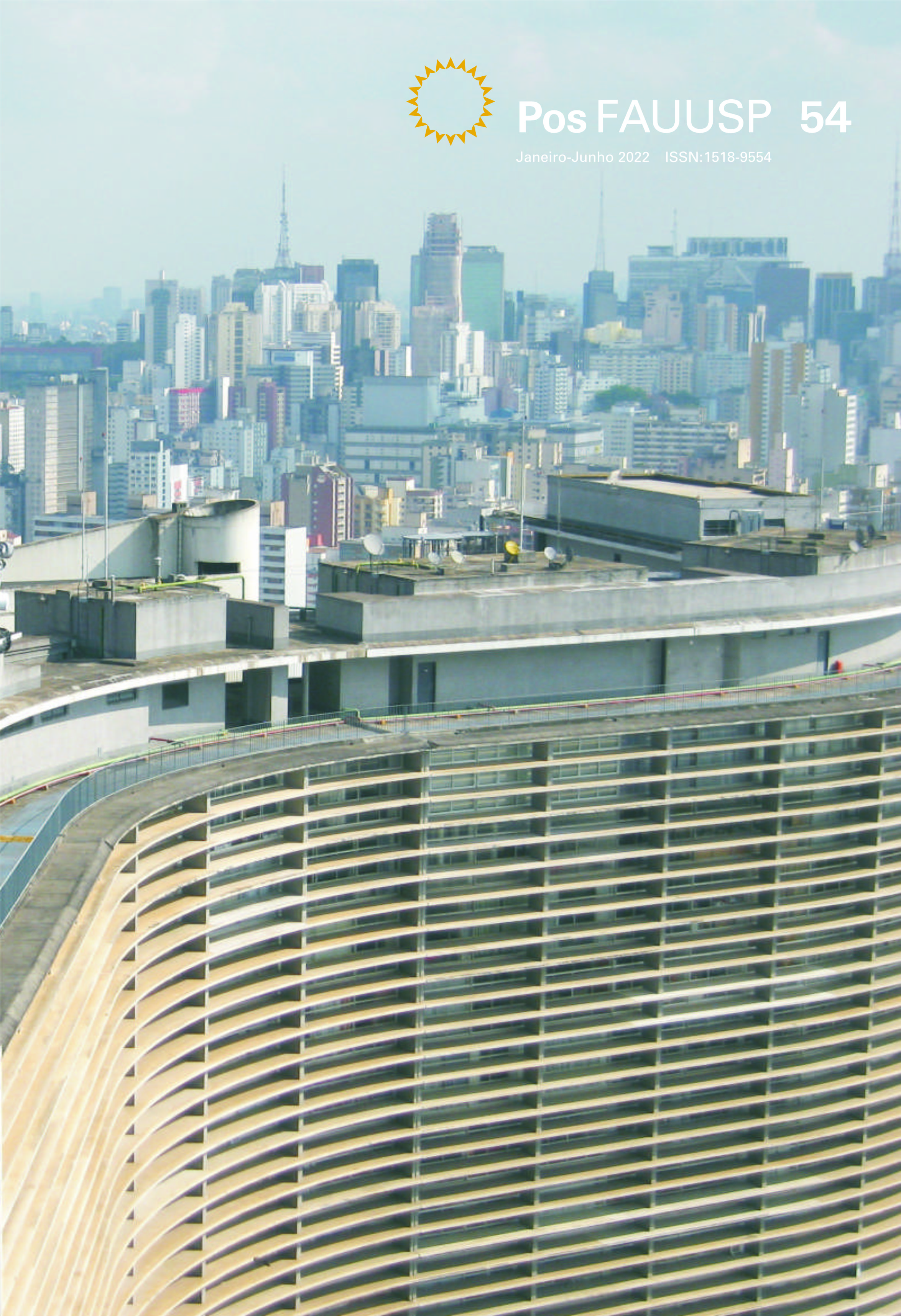A Construção das Ideias Arquitetônicas
DOI:
https://doi.org/10.11606/issn.2317-2762.posfauusp.2022.184795Palavras-chave:
Criatividade, Ideação, Projeto de arquitetura, Resolução de problemasResumo
Este trabalho discute o modo como as ideias são construídas no processo de projeto de arquitetura e urbanismo, apontando o que possibilita seu surgimento, desenvolvimento, seleção e eliminação. Utiliza-se, para isso, um método de pesquisa qualitativa e exploratória. O pressuposto básico é o de que as ideias são fruto sobretudo do conhecimento, embora influenciadas por fatores subjetivos do projetista: a crítica atua como um filtro da ideação governando, assim, o processo de seleção e descarte de ideias. Os dados foram levantados em entrevistas realizadas com estudantes de graduação da Escola de Arquitetura da UFMG. A análise crítica dos dados levou em consideração teorias, pressupostos e argumentos de outros pesquisadores do assunto, procurando confrontá-los com os achados das entrevistas. Após essa análise, foi possível vislumbrar um padrão na construção de ideias no processo de projeto, que coloca em escrutínio o argumento de que as ideias surgem da interação entre o projetista e o desenho. Espera-se investigar esse padrão mais profundamente, visando sua validação ou refutação.
Downloads
Referências
ARCHER, Bruce. Systematic Method for Designers. In: CROSS, Nigel (Org.). Developments in Design Methodology. New York: John Wiley & Sons, 1984. p. 57 – 82.
CHAI, Kah-Hin, XIAO, Xin. Understanding design research: a bibliometric analysis of Design Studies (1996 – 2010). Design Studies.Vol.23, n.3, jan. 2012. p. 24-43. DOI:https://www.sciencedirect.com/science/article/abs/pii/S0142694X11000524?via%3Dihub
CROSS, Nigel. Designerly Ways of Knowing. London: Springer, 2006. 114p.
CROSS, Nigel (Org.). Developments in Design Methodology. New York: John Wiley & Sons, 1984. 357p.
DARKE, Jane. The Primary Generator and the Design Process. In: CROSS, Nigel (Org.). Developments in Design Methodology. New York: John Wiley & Sons, 1984. p. 175 - 188.
DIETRICH, Arne (2016). Interview given by Arne Dietrich. nov. 2016. Available in <https://www.youtube.com/watch?v=Krd4pbdxBN0>. Access in: feb, 3rd. 2019.
DUBBERLY, Hugh; PANGARO, Paul. Cybernetics and Design: Conversations for Action. Cybernetics and Human Knowing. Vol. 22, nos. 2-3, 2015, p. 73-82. DOI:https://link.springer.com/chapter/10.1007%2F978-3-030-18557-2_4
DUNBAR, K. How scientists think: On-line creativity and conceptual change in science. In: WARD, T.B., SMITH, S. M. e VAID, J. (Orgs.), Creative thought: An investigation of conceptual structures and processes. Washington, DC: American Psychological Association, 1997. p. 461 - 494.
ERICSSON, K. A.; SIMON H. A. Protocol analysis: Verbal reports as data. Cambridge: MIT Press. 1993. 500p.
GERO, John S. ; TANG, Hsien-Hui. The Differences Between Retrospective and concurrent protocol in revealing the process-oriented aspects of the design process. Design Studies. Vol. 22, n. 3, 2001, p. 283-295. DOI: https://doi.org/10.1016/S0142-694X(00)00030-2
GOLDSCHMIDT, Gabriela. The Dialectics of Sketching. Creativity Research Journal. Vol.4, n.2, 1991, p. 123 - 143. DOI:https://www.tandfonline.com/doi/abs/10.1080/10400419109534381
HILLIER, Bill. Space is the Machine: A Configurational Theory of Architecture. London: Space Syntax, 2007. 355p.
HILLIER, Bill, MUSGROVE, John e O’SULLIVAN, Pat. Knowledge and Design. In: MITCHELL, W.J. Environmental design: research and practice 2. Proceedings of the EDRA 3/AR 8 Conference, 1972. p.29-3-1 –p.29-3-14.
KAUFMAN, James C.; Robert J. STERNBERG. The Cambridge Handbook of Creativity. Cambridge: Cambridge University Press, 2010.
LANDAY, J A; MYERS, B. Interactive Sketches for the early stages of user interface design. In: Human Factors in Computing Systems, CHI ‘95 Conference Proceedings. 1995, p. 43-50.
LAWSON, Bryan. How Designers Think. Cambridge: Cambridge University Press, 1990. 243p.
LLOYD, Peter; LAWSON, Bryan; SCOTT, Peter. Can Concurrent Verbalizations Reveal Design Cognition? Design Studies. Vol. 16, n. 2, 1995, p. 237-259. DOI: https://doi.org/10.1016/0142-694X(94)00011-2
LOCHER, Paul J. How Does a Visual Artist Create an Artwork? In: KAUFMAN, James C.; Robert J. STERNBERG. The Cambridge Handbook of Creativity. Cambridge: Cambridge University Press, 2010. p. 131 – 144.
MALARD, Maria Lúcia. Projeto arquitetônico e pensamento científico. Na Gênese das racionalidades modernas. Belo Horizonte: Editora UFMG, 2013, vol. 1, p. 259-274.
MALARD, Maria Lúcia. O futuro do projeto em arquitetura e urbanismo: ensino e pesquisa. In: CAMPOMORI, Mauricio José Laguardia. (Org.). Aprender fazendo: ensaios sobre o ensino de projeto. Belo Horizonte: Escola de Arquitetura da UFMG, 2018, p. 95-110. Pos FAUUSP 13 Pos FAUUSP, São Paulo, v. 29, n. 54, e184795, jan-jun 2022.
OSTROWER, Fayga. Criatividade e Processos de Criação. 30 ed. Rio de Janeiro: Ed. Vozes, 2018. 186p.
POPPER, Karl. Conjecturas e Refutações. 4 ed. Brasília: Ed. UnB, 1972.
RITTEL, Horst. On the Planning Crisis: Systems Analysis of the “First and Second Generations”. Bedriftsøkonomen. Oslo. n.8, 1972, p.390 - 396.
RUNCO, Mark A. Divergent Thinking, Creativity and Ideation. In: KAUFMAN, James C.; Robert J. STERNBERG. The Cambridge Handbook of Creativity. Cambridge: Cambridge University Press, 2010. p. 415 – 446.
SCHÖN, Donald. The Reflective Practitioner: How Professionals Think in Action. New York: Basic Books, 1983. 376p.
SUWA, Masaki; TVERSKY, Barbara. What do architects and students perceive in their design sketches? A protocol analysis. Design Studies. Vol. 18, n. 4, 1997, p. 385-403. DOI: https://doi.org/10.1016/S0142-694X(97)00008-2
WEISBERG, R. Creativity and Knowledge: A challenge to Theories. In: KAUFMAN, James C.; Robert J. STERNBERG. The Cambridge Handbook of Creativity. Cambridge: Cambridge University Press, 2010. p. 226 – 248.
Downloads
Publicado
Edição
Seção
Licença
Copyright (c) 2022 Isabel Caldeira Brant, Maria Lúcia Malard

Este trabalho está licenciado sob uma licença Creative Commons Attribution-NoDerivatives 4.0 International License.
O detentor dos direitos autorais é o autor do artigo. A revista exige apenas o ineditismo na publicação do artigo. O autor tem do direito de divulgar seu artigo conforme sua conveniência devendo citar a revista.
DIADORIM - Diretório de Políticas Editoriais












